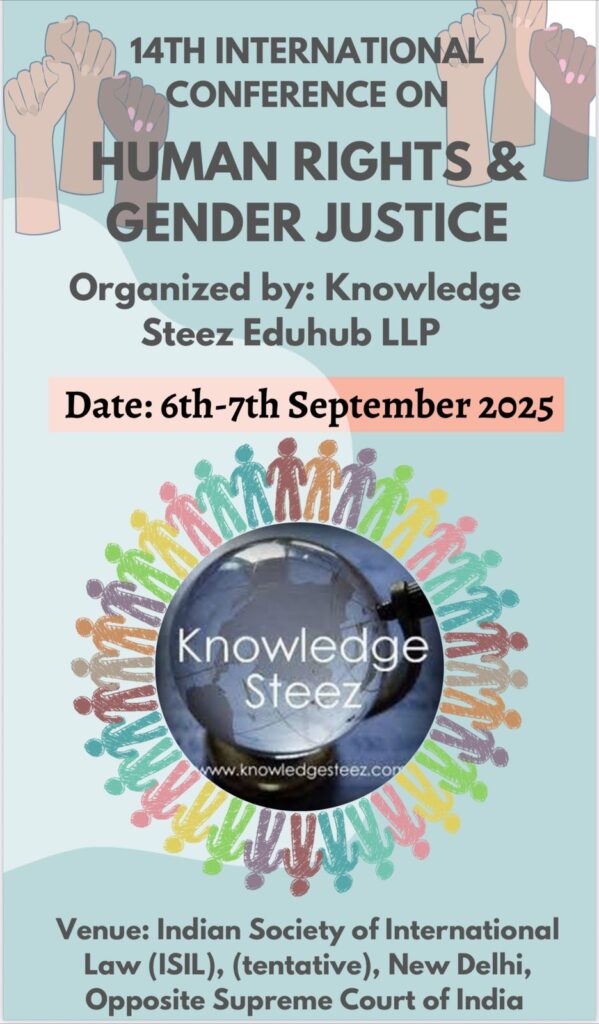Abstract:
This comprehensive article provides an in-depth analysis of the multifaceted role played by the Indian judiciary in promoting gender equality within Indian society. With a broader perspective, it explores the legal framework surrounding gender equality, significant Supreme Court rulings and orders, challenges in implementing gender equality laws, the benefits and potential drawbacks of gender equality, a comparative study of gender equality in pre and post-independent India, and concludes by emphasizing the need for sustained efforts to achieve comprehensive and meaningful gender equality in India.
Introduction :-
Gender equality is a fundamental principle of a democratic and just society, ensuring that all individuals, regardless of their gender, have equal rights, opportunities, and treatment. In India, the judiciary has emerged as a key player in shaping and enforcing laws that aim to promote gender equality. Through landmark judgments and progressive interpretations, the Indian judiciary has sought to address discriminatory practices, rectify gender imbalances, and ensure equal rights and opportunities for all genders. This article delves into the broader aspects of the role of the Indian judiciary in advancing gender equality, shedding light on the legal framework, notable court rulings, challenges, benefits, drawbacks, and a comparative study of gender equality in pre and post-independent India.
Legal Framework for Gender Equality :-
The legal framework surrounding gender equality in India includes constitutional provisions, legislative acts, and international conventions. The Constitution of India guarantees fundamental rights to all citizens, including the right to equality and protection against discrimination. Additionally, various legislative acts have been enacted to address specific gender-related issues, such as the Protection of Women from Domestic Violence Act, the Sexual Harassment of Women at Workplace (Prevention, Prohibition, and Redressal) Act, and the Dowry Prohibition Act. India is also a signatory to international conventions and agreements that advocate for gender equality, such as the Convention on the Elimination of All Forms of Discrimination Against Women (CEDAW).
Significant Supreme Court Rulings and Orders:-
The Supreme Court of India has played a pivotal role in shaping gender equality jurisprudence through landmark judgments and progressive interpretations of the Constitution. The Vishaka v. State of Rajasthan case established guidelines for preventing sexual harassment in the workplace. The Triple Talaq case declared the practice of instant divorce through triple talaq among Muslims as unconstitutional. The court has also recognized the right to equality, reproductive rights, and protection against gender-based violence.
Furthermore, the Supreme Court has widened the scope of fundamental rights to encompass gender equality. The concept of substantive equality, which goes beyond formal equality, has been upheld. The court has recognized the importance of affirmative action to address historical disadvantages faced by women, promoting inclusivity and equal opportunities.
Challenges in Implementing Gender Equality Laws:-
Despite the existence of progressive laws, several challenges hinder the effective implementation of gender equality in Indian society. Deep-rooted patriarchal norms, social biases, and cultural practices often pose obstacles to the enforcement of these laws. Gender stereotypes, discriminatory traditions, and societal resistance impede progress towards gender equality. Additionally, lack of awareness, limited access to justice, inadequate infrastructure, and slow judicial processes create barriers to seeking redress and achieving meaningful change.
Benefits of Gender Equality:-
Gender equality brings significant benefits to society as a whole. It fosters social progress by challenging rigid gender roles and stereotypes, promoting inclusivity, and creating a more harmonious society. Economically, gender equality contributes to sustainable development by expanding the talent pool, increasing productivity, and reducing gender-based wage gaps. Political stability is enhanced when women have equal opportunities to participate in decision-making processes, leading to more representative governance. Gender equality also contributes to reducing violence against women, promoting healthier relationships, and fostering an environment of respect, dignity, and safety for all.
Drawbacks of Gender Equality:-
While gender equality is a crucial goal, it is essential to acknowledge potential challenges or concerns that may arise. Some argue that certain affirmative action measures may unintentionally lead to reverse discrimination or marginalization of other groups. Balancing the promotion of equality with preserving individual rights and opportunities is vital. It requires careful consideration, inclusive policy-making, and continuous evaluation to ensure a fair and equitable approach to gender equality.
Comparative Study of Gender Equality in Pre and Post-Independent India:-
Pre-Independent India (Before 1947):-
In pre-independent India, gender equality was a distant dream. Women had limited legal rights and were subjected to discriminatory laws. For example, the Hindu Succession Act favored male heirs, leaving women with limited inheritance rights. Similarly, under Muslim personal law, the practice of triple talaq allowed for instant divorce, without the consent or involvement of women. These legal barriers perpetuated gender disparities and limited women’s autonomy.
Access to education was another significant challenge for women. Especially in rural areas, girls’ education was neglected, and female literacy rates were considerably lower compared to male literacy rates. This lack of education further limited women’s opportunities and hindered their social and economic empowerment.
Political representation for women was minimal in pre-independent India. Women were largely excluded from participating in the political process, resulting in a lack of female voices and perspectives in decision-making. Patriarchal norms and customs prevailed, leading to the marginalization of women. Practices like child marriage, dowry, and purdah (the seclusion of women) were widespread, further restricting women’s freedom and agency.
In terms of employment, women had limited opportunities. The workforce was predominantly male-dominated, and women were mostly confined to traditional roles such as homemakers and agricultural laborers. Their contributions to society and the economy often went unrecognized and undervalued.
Post-Independent India (After 1947):-
Following India’s independence in 1947, significant efforts were made to address gender disparities and promote gender equality. The Constitution of India guaranteed fundamental rights and equality before the law for all citizens, including women. This laid the foundation for legal reforms aimed at empowering women and combating discrimination.
Access to education became a key focus, and initiatives were undertaken to improve female literacy rates. Efforts were made to establish schools and educational institutions, especially in rural areas, to ensure girls had equal opportunities to pursue education. Over the years, there has been a significant increase in female literacy rates, enabling women to actively participate in various spheres of life.
Political empowerment of women has also improved in post-independent India. Reservation policies were introduced, providing reserved seats for women in local government bodies (panchayats) and the Parliament. This has led to an increase in the number of women in political positions, enabling them to contribute to decision-making and policy formulation.
Societal reforms have challenged discriminatory practices and norms. Social movements and awareness campaigns have addressed issues like dowry, female infanticide, and violence against women. Efforts have been made to change mindsets, promote gender equality, and empower women at the grassroots level.
Although progress has been made, several challenges persist in post-independent India. Gender-based violence, unequal pay, and societal attitudes continue to hinder complete gender parity. Women still face barriers in accessing equal opportunities and face discrimination in various aspects of life. Efforts are ongoing to address these challenges through policy interventions, legal reforms, and societal awareness campaigns.
In terms of employment and economic opportunities, women’s participation in the workforce has increased. However, significant gender gaps remain, and women are often concentrated in certain sectors and face limited career growth. Efforts such as the National Rural Livelihood Mission and the Stand Up India initiative aim to promote women’s economic empowerment and entrepreneurship.
Conclusion :-
The Indian judiciary has played a pivotal role in promoting gender equality in Indian society. Through landmark judgments, progressive interpretations, and the recognition of fundamental rights, the judiciary has contributed significantly to the advancement of gender equality. However, achieving comprehensive and meaningful gender equality requires sustained efforts and collective action. Addressing the challenges, including deep-rooted patriarchal norms, social biases, and implementation gaps, is crucial. Continuous reforms, awareness campaigns, education, and changes in societal attitudes are essential to create an inclusive society where all genders can thrive. By consolidating progress, fostering inclusive dialogue, and striving for justice, India can move closer to achieving comprehensive gender equality, creating a society that respects and upholds the rights and dignity of all individuals.
References :-
● M.P Jain :- Indian Constitutional Law Eighth Edition .
● J.N Pandey :- Constitutional Law of India.
● Professional Bar Act :- Indian Constitutional .
● The Hindu Daily News Paper.
By :-
Dhiraj Kumar Sharma
Student of BA LL.B Semester :- VI th
University Law College ( Vinoba Bhave University ) Hazaribag Jharkhand .









